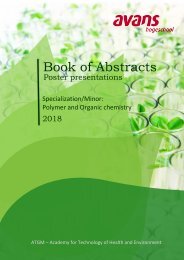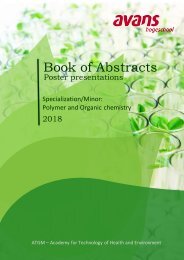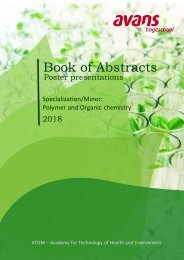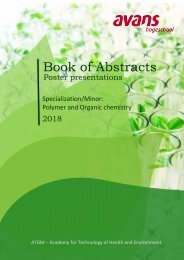Book of abstracts eindversie
You also want an ePaper? Increase the reach of your titles
YUMPU automatically turns print PDFs into web optimized ePapers that Google loves.
Synthesis <strong>of</strong> Poly(Glycerol Succinate – Co – Maleate)<br />
PLA enhancer 1<br />
Author<br />
Jacoline Synthesis van Es <strong>of</strong> Poly(Glycerol Succinate – Co – Maleate)<br />
Academy <strong>of</strong> Technology for Health and Environment<br />
PLA enhancer 1<br />
Avans Hogeschool, Breda<br />
Jack van Schijndel<br />
Abstract<br />
Synthesis <strong>of</strong> Poly(Glycerol Succinate-Co-Maleate): PLA<br />
We use polymers every day, but most <strong>of</strong> them come from oil sources. There are now researches going on to recycle<br />
polymers and get them from biobased sources, for example from trees. A complex present in trees which is known as<br />
lignin, can be broken down to sinapic acid. Sinapic acid can be converted to styrene-like monomers (figure 1), which is<br />
enhancer 1<br />
proved by this project.<br />
The goal <strong>of</strong> this project was to optimize the decarboxylation <strong>of</strong> sinapic acid to canalol, which included a high yield and<br />
purity. The hypothesis was that this would be the best with a metal-ligand complex, with dry glassware in a nitrogen<br />
environment [1] [2].The standard procedure was with copper idone and HMTA in 0,025 mol% to sinapic acid at 115⁰C [.<br />
To find the best circumstances, we first tested the influence <strong>of</strong> water and oxygen by the standard procedure.<br />
The next step was a full factorial design, which tested 3 factors (low and high): temperature (100⁰C; 130⁰C), copper iodine<br />
(0; 0,05) and HMTA (0; 0,05). As center point we took the standard procedure.<br />
It is found that water, oxygen and copper iodine have a negative influence on the purity and yield. HMTA and<br />
temperature are positive for purity and yield, between the given ranges, which is shown in figure 2.<br />
Keywords: Decarboxylation, Bioabased monomers, DoE<br />
Table <strong>of</strong> content<br />
Figure 9: Decarboxylation from sinapic acid<br />
to canalol.<br />
Figure 10: Result DoE: influence <strong>of</strong> head factors.<br />
[1] S. Cadot, „Preparation <strong>of</strong> functional styrene,” Green chemistry, vol. 16, 2014.<br />
[2] Y. Zou, „CuI/1,10-ogeb/PEG decarboxylation <strong>of</strong> 2,3 diarylacrylic acids,” organic and biomolecular chemistry, nr. 11, pp.<br />
6967-6975, 2013<br />
[3] L. Nijsen, „Synthesis, pufification and polymerisation <strong>of</strong> various biobased styrene derivates,” Avans Journal <strong>of</strong> Talents.<br />
32









